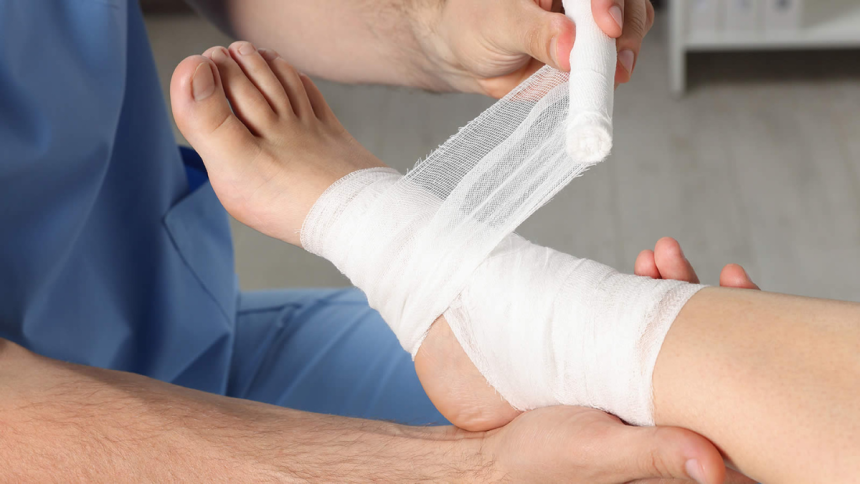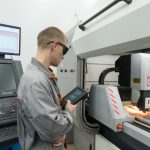Injuries on feet and their support structures can interrupt how you navigate stairs, perform daily tasks, enjoy sports, or even rest comfortably on the couch. At this point, seeking medical intervention from a specialist is handy. That is where skilled podiatric intervention helps you regain independence, restore function, and preserve long-term comfort. Professional and focused care offers a structured path from pain to recovery.
1. High Ankle Sprain: Fast Pain Relief and Stabilization
Ligament damage around the ankles remains among the most frequent foot injuries. Such may range from microscopic tears to partial tearing, and complete ligament rapture. Such injuries can result from quick pivots, awkward landings, or uneven surfaces.
Professional diagnostic process includes:
- Physical examination for tenderness, bruising, and joint laxity
- Medical imaging to assess soft tissue integrity
- Stress testing to determine the extent and specific ligaments involved
Ankle Sprain Treatment Abingdon MD experts will focus on the root cause of instability, the severity and location of the ligament injury, to determine the most effective recovery plan. These skillfully intervene using external support devices such as braces, walking boots, custom orthotics, and specialized taping techniques to stabilize the joint. Also, gentle icing and anti-inflammatory support can help in pain relief. However, prompt podiatric care is crucial in stopping the recurrence cycle and initiating structured healing.
2. Treating Acute Foot Injuries: Dedicated and Skillful Intervention
Foot trauma isn’t always dramatic. A hit from a dropped object, misstep, or hard landing can create deep bruises or fractures in the midfoot bones. These injuries may appear as atypical presentation of strain leading to misdiagnosis. Hence, such expert evaluation.
Watch out for signs like:
- Intense pain, swelling, or bruising
- Weight-bearing pain
- Bones misalignment
In case you experience any of these symptoms, prompt podiatric attention is essential to prevent long-term complications.
Podiatric care pathways may include:
- Stabilization with a cast or walking boot for stable, non-displaced fractures
- Surgical referral for displaced or complex breaks
- Physiotherapy focusing on flexibility, strength, and functional recovery
For many, effective treatment and quick recovery mean more than just healing—it’s a lifeline to returning to work, enjoying time with family, and staying an active, pain-free lifestyle.
3. Sports-Related Musculoskeletal Injuries: A Modern, Multi-Level Response
Rugby players, acrobats, movie actors, and other biomechanically dependent individuals are at heightened risk for complex musculoskeletal issues. Treatment of these injuries demands expert solutions. Maryland-based podiatrists like Mountain Spring Podiatry are leveraging an integrative, performance-aware approach to diagnosing and treating these injuries. Their care model combines clinical precision, modern treatment options, and person-first care.
These experienced podiatrists assess cases as it is, moving away from one-size-fits-all solutions, to develop individualized recovery plans. Such interventions may include:
- Individualized tendon repair and tendinopathy relief based on patient-specific factors
- Early identification and monitoring of stress fractures using imaging like MRI or CT scans
- Custom orthotics that stabilize gait and reduce repetitive strain on joints
- Tailored rehabilitation strategies tailored to both the injury and the individual’s sport or lifestyle
- Podiatric surgery
Such interventions balance healing with the athlete’s desire for fast, safe re-entry into training or competition. In recreational and professional athletes alike, this modern approach protects not only performance but long-term limb integrity.
4. Forefoot and Midfoot Trauma: Identifying the Often Overlooked
Lower limb trauma, even when it feels like a minor twist or fall, can hide deeper structural damage. Without proper identification and management, these conditions can deteriorate fast.
Common symptoms include:
- Midfoot pain while pushing off or bearing weight
- Swelling on the dorsum of the foot
- Pain at the ball of the foot or near the toes
- Difficulty fitting into everyday footwear
Podiatrists trained in podiatry mechanics ensure that even complex injuries are managed with precision and long-term support.
For example, patients with stable fractures may require temporary immobilization such as casts, plates, extensions, and posterior splints. Specialized doctors will assess the phase of healing, fracture displacement, and location to develop the most appropriate clinical decision and patient advice.
5. Integrated Podiatric Rehabilitation: Stopping Recurrence and Rebuilding Strength
Recovery journey doesn’t end when pain subsides—it culminates in total restoration of activity. That is where podiatric rehabilitation becomes invaluable, infusing comprehensive care while bridging the gap between treatment and independent movement.
Core components of a podiatric-guided rehab program include:
- Strength training to stabilize muscles around injured joints
- Balance work using wobble boards and proprioceptive drills
- Manual therapy to reduce stiffness and improve range of motion
- Mobility retraining to restore natural walking patterns
- Transition guidance through footwear optimization and orthotic support
The undertaking of these protocols by certified doctors reduces the risk of reinjury, particularly in patients prone to recurring sprains or instability. Your podiatrist will extend help to enhance home-based routines and follow-up assessments.
In conclusion, foot-related injuries don’t have to sideline your ambitions or limit your independence. Whether it is pain limiting you, discomfort, flexibility issues, or cosmetic issues on your foot, working with a podiatrist makes the healing purposeful and results lasting- thus renewing your vigor. However, identify a clinic offering a blend of expertise, advanced tools, and patient-first care.
Lynn Martelli is an editor at Readability. She received her MFA in Creative Writing from Antioch University and has worked as an editor for over 10 years. Lynn has edited a wide variety of books, including fiction, non-fiction, memoirs, and more. In her free time, Lynn enjoys reading, writing, and spending time with her family and friends.















